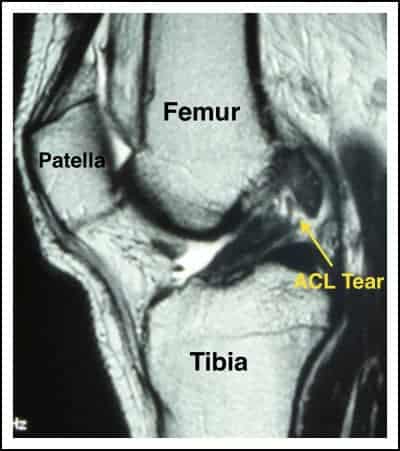Are Women More Likely to Suffer a Torn ACL Than Men?
- What is the ACL?
- Why are Women More Likely Than Men to Tear the ACL?
- What Are ACL Tear Treatment Options?
- How Is ACL Repair Surgery Performed?
- What Are the Results of ACL Repair Surgery?
- How Can Female Athletes Prevent ACL Tears?
Ask any athlete if they are familiar with anterior cruciate ligament (ACL) injuries and most will just cringe.
For female athletes, the problem ACL has been a particular source of issue with recent research finding that women are more susceptible to tears than men. But why do females suffer four to five times more ACL tears than male athletes do?
First, it’s important to understand what the ACL is.
What is the ACL?
The ACL is one of the ligaments used to help to stabilize the knee. It is an important ligament that runs through the mid-section of the knee joint. In most instances, it tears due to jumping or when there is a sudden landing or quick change of direction. A great majority of ACL tears are non contact injuries.
An ACL tear is one of the most common injuries to sideline athletes every year. Tears can occur with or without contact and approximately 1 in 3,000 athletes will experience a torn ACL in any given year.
Why are Women More Likely Than Men to Tear the ACL?

An MRI of a torn ACL.
“There are many different theories that have been generated as to why women have more ACL tears than men,” says Randy S. Schwartzberg, M.D., a board certified sports medicine specialist at Orlando Orthopaedic Center. “While there is not one ironclad reason that explains it all, the current widely accepted explanation has to do with neuromuscular differences between males and females.”
When compared to men, the female body responds differently to certain maneuvers such as jumps, sudden stops, pivoting and cutting. Females are also shown to land with less knee flexion (bend in the knees) and valgus (meaning their knees angle in and touch one another when the legs are straightened – a term often called “knock knees”).
What Are ACL Tear Treatment Options?
There are both nonsurgical and surgical treatment options depending on the severity of the ACL injury. Nonsurgical treatments include physical therapy and rehabilitation, which can help restore the knee while improving stability in the region. In many cases, there are other areas, such as the meniscus and surrounding cartilage, that are injured along with the ACL and those injuries must be evaluated and treated as well.
“Unfortunately for most all athletes, surgery is the treatment choice for complete ACL tears. These modern, often minimally invasive procedures allow the patient to regain full function and return to the sport they love in most instances,” says Dr. Schwartzberg. “In many cases, when the ACL is reconstructed through surgical means it typically has a long term success rate and patients report a satisfactory outcome.”
When surgery is required, the goal is to restore stability of the knee by restoring the function of the torn ACL.
How Is ACL Repair Surgery Performed?
For those who need surgery, the ACL ligament will be replaced entirely. The ligament is replaced with a tendon, which then acts as a graft. The graft will mature over time and become a new, living ligament.
Grafts to replace the ligament and stabilize the knee may come from the patellar tendon, the hamstring tendon or the quadriceps tendon. Grafts can be taken from two sources: autografts (from the patient’s body) or allografts (from a cadaver). The surgeon will decide upon the type of graft depending on the patient’s lifestyle needs and expected sizes of potential autografts.
Even though women are more likely to sustain this type of injury to the knee, there is no major difference in the surgical procedures for males and females. In most cases, after physical therapy and rehabilitative services, women can return to their normal sporting activities.
What Are the Results of ACL Repair Surgery?
ACL surgeries are usually successful with more than 90 percent of patients being able to return to sports and workplace activities without symptoms of knee instability, according to the American Orthopaedic Society for Sports Medicine.
What this means for female athletes like McKenzie Clark, a former patient of Dr. Schwartzberg’s, is that they can return to the sports they love after a successful rehabilitation course.
Clark had ACL reconstruction surgery and was back on the soccer field playing within five months. After surgery, she underwent physical therapy and was able to meet her goal of being ready for the Olympic Development Program first round tryouts less than six months later. Clark says that she is stronger both physically and mentally after the surgery and she no longer worries about her knee.
“I have a lot more confidence in my ability to do these things, even if my mind tells me I can’t, I know my body can,” she says.
How Can Female Athletes Prevent ACL Tears?
There are some ways that female athletes can help prevent ACL tears.
“Proper conditioning is a well-established general principle that may help prevent many types of injuries. It is important to train the body year-round, not just during specific sports seasons,” says Dr. Schwartzberg. “We believe injury prevention education and training is vital to help reduce the risk of sports injuries in both male and female athletes throughout Central Florida.”
In fact, one of the main goals of Orlando Orthopaedic Center’s 501(c)(3) nonprofit is funding orthopaedic injury prevention programs to reduce the risks of injuries on the field and on the job.
When training, specific attention should also be paid to strengthening of the hamstrings and quadriceps, which directly influence the mechanics of the knee.
“Validated ACL and lower extremity programs emphasize training athletes on proper ways to perform various athletic maneuvers,” says Dr. Schwartzberg. “Such examples include training proper mechanics for jumping, landing from jumps, pivoting and cutting.”
The prevention plan involves using a program that addresses those differences and can be executed before games and practices.
“By training appropriate motions and doing them properly and repetitively, we hope that we can reduce the risk of injury in female athletes,” says Dr. Schwartzberg.



